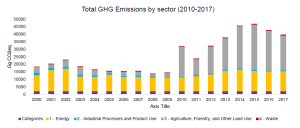

ZIMBABWE currently has a climate financing gap of between US$500 million, limiting the southern African country’s ability to build climate resilience, it has been revealed.
The impacts of climate change in Zimbabwe are now visible in all socio-economic sectors through the effects of droughts, prolonged dry spells, intense tropical storms and other extreme weather events.
The country’s climate is predominantly semi-arid and is extremely variable and prone to shifting rainfall patterns, droughts and periodic floods in certain parts of the country, which has severe implications for climate-sensitive economic sectors and food security.
 Climate change is exacerbating these problems by increasing the frequency and intensity of such extreme weather events.
Climate change is exacerbating these problems by increasing the frequency and intensity of such extreme weather events.
The 2015/2016 El Nino event caused a significant drought, which was declared a State of Disaster and left over 4,1 million people in need of food support.
In 2019, Tropical Cyclone Idai left more than 300 people dead, hundreds missing and 270 000 affected in Chimanimani, Chipinge, Buhera and Chiredzi Districts according to official figures.
According to the African Development Bank (AfDB), Zimbabwe has prioritised private financing to achieve its climate change targets in transitioning to green and inclusive growth.
“The country is developing the National Climate Change Fund and Climate Finance Facility to crowd in the private sector through blended finance and results-based approaches to de-risk markets and scale up investment and boost participation in scaling up climate actions. Zimbabwe received about US$990 million in climate finance between 2010 and 2020, averaging US$90 million a year. This leaves a financing gap of US$440–500 million a year, thus greatly limiting the country’s ability to build climate resilience,” the AfDB said in its country outlook.
The AfDB said considering the significant challenge Africa faces due to climate change and the gap in climate finances, Africa can leverage its natural capital to finance a green transition.
“With the global conversation around long-term, low-carbon, green transformation, and the energy transition taking hold now more than ever, the values of sunshine, wind, and water for hydropower should be considered renewable energy sources and valued as such,” the development funder said.

“Africa is by far the world’s richest region for low-cost renewable energy potential, approaching half (44,8 percent) of the total global technical potential of renewable energy. Given its abundant solar and wind resources, the continent has the world’s best potential to produce cheap hydrogen, though it is yet to benefit from this potential.”
The AfDB said as the world transitions toward a low-carbon and green economy, Africa’s fossil fuel reserves may risk becoming unusable or uneconomical.
Sorry. No data so far.

